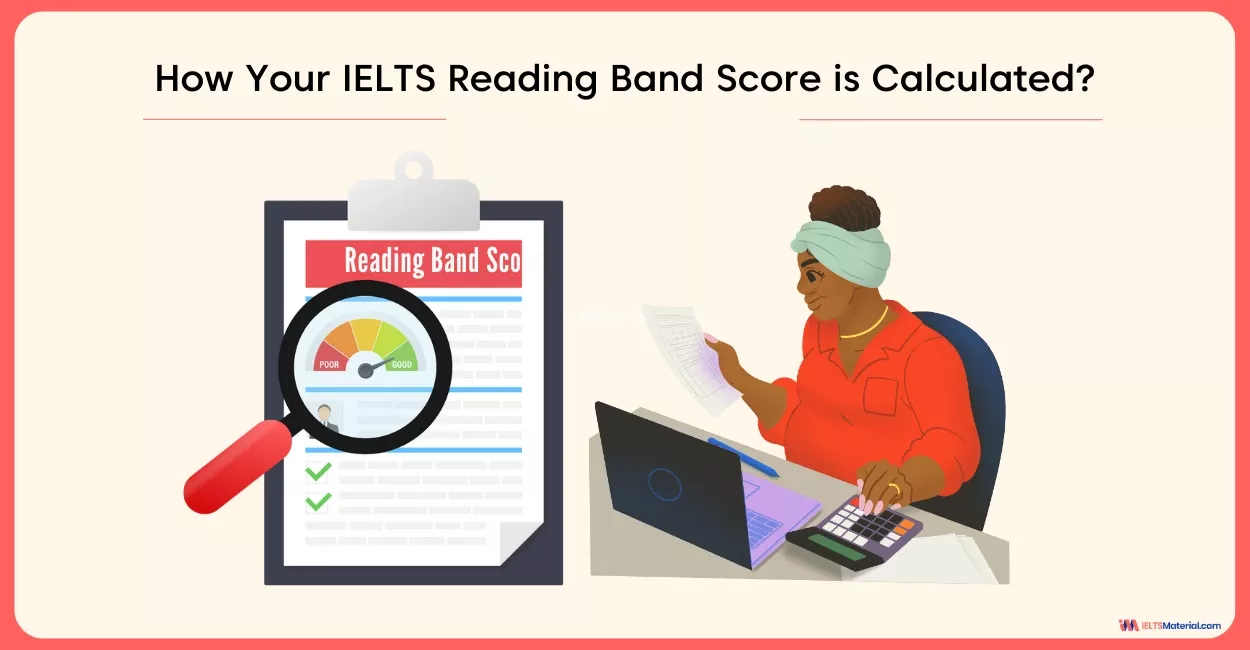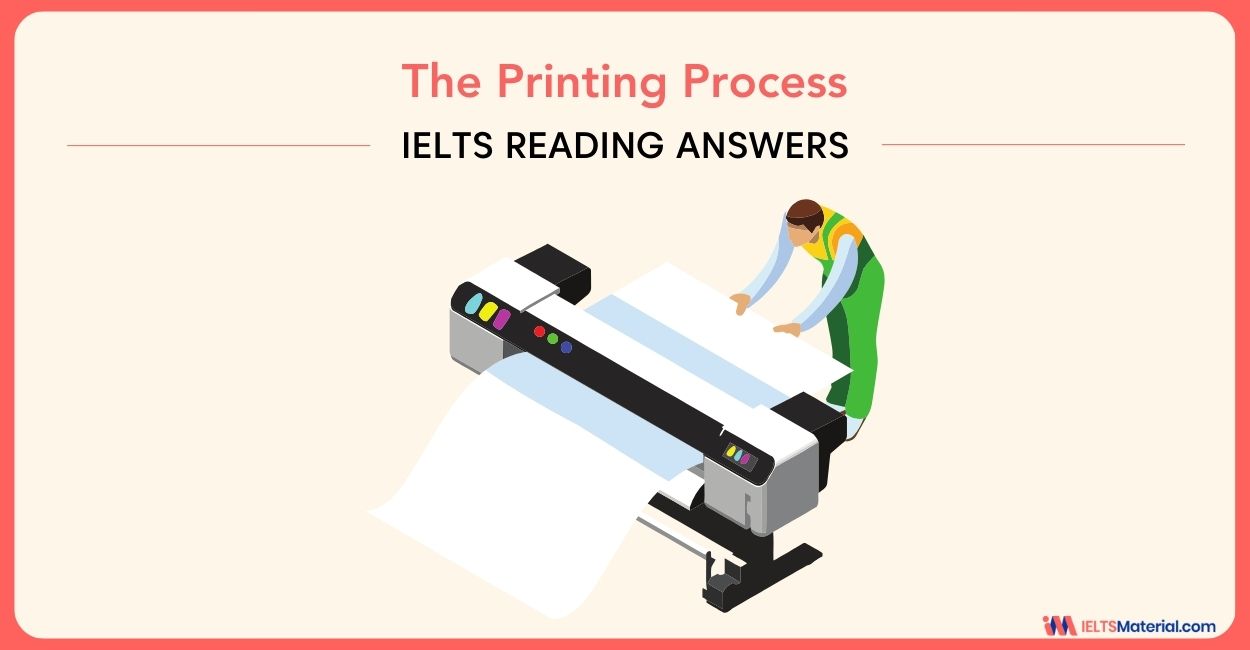The Printing Process IELTS Reading Answers
7 min read
Updated On
-
Copy link
Struggling with tricky IELTS Reading questions? Explore The Printing Process answers with detailed explanations and smart tips for each question type to boost your score and reading skills.
Table of Contents

Limited-Time Offer : Access a FREE 10-Day IELTS Study Plan!
The Printing Process is a passage that appeared in the IELTS General Reading exam. With diligent practice of this passage, you can ensure that your Reading skills are up to the mark and the reading module can be the top-scoring category for you. So, understand how to approach and answer the different question types in the reading module to achieve a top score.
There are 8 questions in the reading passage, The Printing Process. You must understand the subject, look up key terms in the IELTS reading passages, and then respond in line with the instructions. The type of question found in this passage is:
- Sentence Completion (Q. 1-8)
Practice the reading passage, The Printing Process, below, and for more, try IELTS reading practice tests. But, before you take the test, learn some tips from this video to get that perfect IELTS reading score!
The Printing Process IELTS Reading Passage
The world entered its first information revolution when the first printing press was built in 1450. Before this, typical ways of recording information were to carve words onto clay tiles and bamboo, or to write on parchment or papyrus. Fast forward to the digital age, the second information revolution, and it has now become possible to self-publish, have books printed in paperback or as an e-book, and some books are even free!
Digital warehouse
Long gone are the days when every book was printed before there was a buyer. Why print thousands of books only to find out that very few people want to buy them? Now it is possible to work with a printer in a process called Print On Demand (POD) and only print a paperback when you have an order.
To do this a printer has a digital warehouse with every book stored electronically. Once an order is placed, the printer has all of the electronic data necessary to print and deliver the book to its intended destination. Every month money is sent to all of the authors that have sold books that month.
Giving your book to the printer
Once written, an author can send his book electronically to the printer in the form of a PDF file or as a hardcopy that can be scanned and digitized by the printer.
Processing fees for all services from a printer are minimal but allow you to have access to large distribution networks of not only online bookstores but also the bricks and mortar retailers. These people may not buy your book but your book will be in their catalogues and they will order from the printer if someone asks for it.
Two Concerns
Speed is not the only priority for the printer, they are also concerned with quality and have 10 quality control checks on each book before it is shipped.
Sharp graphics and crisp text make it virtually impossible to distinguish a POD book from the more traditional offset copies. As technology continues to improve this can only get better.
As an author, it is possible to choose the type of book you want; paperback, hardback, or e-book (now the most popular form of book), the size of your book, type of paper, and type of cover (laminated, cloth or jacketed for hardbacks).
Want to improve your IELTS Academic Reading score? Grab Our IELTS Reading Ebook Today!
The Printing Process IELTS Reading Questions
Questions 15– 20
Complete the sentences below.
Choose NO MORE THAN THREE WORDS from the passage for each answer.
Write your answers in boxes 15– 20 on your answer sheet.
15 We experienced our first information revolution with the development of the ……………………
16 It is no longer necessary to print books in …………………….
17 Print On Demand works by making sure that the printer has been given all of the relevant …………………….
18 If necessary the printer will scan and digitize your …………………….
19 The latest technology makes the difference between offset printing and Print On Demand almost …………………….. to tell.
20 Apart from the traditional hardback and paperback books, authors can now publish in …………………….. form.
Want to boost your IELTS score? Enroll in our expert-led IELTS online classes today!
The Printing Process IELTS Reading Answers With Explanation
Let’s now review the answers to the questions from the passage in the reading section, The Printing Process IELTS Reading Answers, and assess your improvement for a high IELTS Reading band score.
15 Answer: printing press
Question type: Sentence Completion
Answer location: Paragraph 1, line 1
Answer explanation: The given lines say that “The world entered its first information revolution when the first printing press was built in 1450.” As it is clear that we (the world) experienced our first information revolution with the development of the first printing press in 1450, the answer is ‘printing press’.
16 Answer: thousands
Question type: Sentence Completion
Answer location: Paragraph 2, line 2
Answer explanation: In the mentioned line, a question is asked, “Why print thousands of books only to find out that very few people want to buy them?” This points to the fact that the writer feels it is no longer necessary to print books in thousands when there are very few buyers. Hence, the answer is ‘thousands’.
17 Answer: electronic data
Question type: Sentence Completion
Answer location: Paragraph 3, line 2- line 3
Answer explanation: In the quoted lines, it is said that “Once an order is placed, the printer has all of the electronic data necessary to print and deliver the book to its intended destination.” This statement points out that, with the Print On Demand service, the printer stores all the electronic data that is necessary and prints once the order is placed. Hence, the answer is ‘electronic data’.
18 Answer: hard copy
Question type: Sentence Completion
Answer location: Paragraph 4
Answer explanation: The paragraph specifies that “Once written, an author can send his book electronically to the printer in the form of a PDF file or as a hardcopy that can be scanned and digitized by the printer.” It is clear that if necessary, the printer will scan and digitize the hard copy which the author sends in a PDF format. Hence, the answer is ‘hard copy’.
19 Answer: impossible
Question type: Sentence Completion
Answer location: Paragraph 7
Answer explanation: The seventh short paragraph says that “Sharp graphics and crisp text make it virtually impossible to distinguish a POD book from the more traditional offset copies.” Based on this sentence, it can be concluded that the latest technology makes the difference between offset printing and Print On Demand (POD) almost impossible to tell. Hence, the answer is ‘impossible’.
20 Answer: e-book
Question type: Sentence Completion
Answer location: Paragraph 8
Answer explanation: The last portion of the passage says that “As an author, it is possible to choose the type of book you want; paperback, hardback, or e-book (now the most popular form of book)…”. It is clear that apart from the traditional hardback and paperback books, authors can now publish in ebook form. Hence, the answer is ‘e-book’.
Tips to Solve the Question Types in The Printing Process IELTS Reading Answers
Let us check out some quick IELTS Exam Preparation Tips for Band Score of 8+ to answer the three types of questions in the Reading Answers.
IELTS Reading Sentence Completion
IELTS Reading Sentence Completion questions test your ability to find and understand specific information from the passage. Use these simple yet effective tips to avoid common mistakes and boost your score.
- Follow the word limit
Always read the instructions carefully. If it says NO MORE THAN TWO WORDS, don’t write three—stick strictly to the word or number limit. - Underline keywords
Identify important keywords in the question to help you scan and locate the relevant part of the passage quickly and accurately. - Check grammar carefully
Ensure that your answer makes grammatical sense in the sentence. Think about what type of word (noun, verb, adjective) is missing. - Look out for paraphrasing
The question and the passage will often use different words with the same meaning. Focus on understanding the idea, not just matching words. - Only write the missing word(s)
Do not rewrite the entire sentence or add extra words. Just include the correct word(s) from the passage to complete the sentence properly.
Confused about IELTS prep? Join our exclusive IELTS webinar and clear all your doubts!
Mastering passages like “The Printing Process IELTS Reading Answers” can significantly boost your Reading IELTS band score. Regular practice with real exam-style questions not only improves speed and accuracy but also builds your confidence. Keep exploring different IELTS Reading passages and refine your techniques to ensure success on test day.
Check More IELTS Reading Answers
| Cod In Trouble Reading Answers | Why Pagodas Don’t Fall Down Answers |
| Anxiety Reading Answers | Australias Sporting Success Answers |
| Saving Language Reading Answers | A Book Review Reading Answers |
Practice IELTS Reading based on question types

Start Preparing for IELTS: Get Your 10-Day Study Plan Today!
Recent Articles

Nehasri Ravishenbagam

Haniya Yashfeen

Haniya Yashfeen

Haniya Yashfeen




Post your Comments